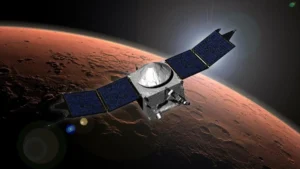China has recently sent a groundbreaking astronomical satellite named Einstein Probe (EP) into space on a mission to observe mysterious transient phenomena in the universe. The satellite, shaped like a lotus in full bloom, employs innovative X-ray detection technology inspired by the functioning of a lobster eye. Launched from the Xichang Satellite Launch Centre in southwest China’s Sichuan Province, this mission marks a significant step in unraveling the secrets of the cosmos.
Lotus-Shaped Wonder: Design and Features of Einstein Probe
The Einstein Probe, weighing approximately 1.45 tonnes and resembling a full-size SUV, boasts a distinctive lotus shape. Its design includes 12 petals and two stamens, with each petal housing wide-field X-ray telescopes (WXT) and each stamen containing follow-up X-ray telescopes (FXT). This unique structure forms a space observatory geared towards capturing elusive celestial events.
Unveiling the Universe’s Hidden Fireworks: Mission Objectives
The primary mission objectives of the Einstein Probe focus on shedding light on enigmatic phenomena in the universe. Scientists aim to capture the first light emanating from supernova explosions, locate and identify X-ray signals accompanying gravitational wave events, and discover dormant black holes and other faint transient celestial objects at the outer reaches of the cosmos.
Einstein’s Legacy: A Nod to General Relativity
The satellite’s nomenclature pays homage to Albert Einstein, the iconic physicist behind the theory of general relativity. Yuan Weimin, the principal investigator of the EP mission and a researcher at the National Astronomical Observatories of the Chinese Academy of Sciences (CAS), emphasizes the connection between the mission’s objectives and Einstein’s groundbreaking predictions.
The Universe’s Explosive Side: Studying Transient Celestial Bodies
While the starry sky appears serene to the human eye, the universe harbors intense celestial activities. Explosions triggered by the demise of supermassive stars, black holes consuming stars, and collisions involving neutron stars and black holes are part of this cosmic drama. The EP mission aims to deepen our understanding of these phenomena, answering fundamental questions about the composition of the universe and the governing laws of extreme celestial environments.
X-ray Vision: Capturing the Unseen with WXT and FXT
The wide-field X-ray telescopes (WXT) on the satellite act as colossal nets, allowing scientists to monitor one-twelfth of the entire sky at once. These instruments are crucial for capturing sudden and unpredictable explosive celestial bodies beyond our galaxy, often emitting X-rays. Additionally, follow-up X-ray telescopes (FXT) boast high sensitivity, facilitating rapid observation and independent discovery of transient sources.
Innovative Technology: CMOS Sensors for X-ray Observation
The EP mission incorporates innovative X-ray astronomical detectors, including CMOS sensors developed by the international team involved in the project. These sensors enhance the satellite’s ability to observe X-ray signals in space, providing valuable data for scientific analysis.
Global Collaboration: The European Space Agency and Max Planck Institute
The mission is a collaborative effort, with participation from The European Space Agency and the Max Planck Institute for Extraterrestrial Physics in Germany. Together, these international entities aim to conduct a high-cadence survey and monitoring of high-energy transient sources, search for cloaked black holes, and study their formation and evolution.
The Quest for New Discoveries: Anticipating Unseen Phenomena
As the EP mission unfolds, scientists express anticipation about discovering new celestial phenomena and bodies never seen before. Yuan Weimin expresses eagerness in exploring the uncharted realms of the universe, emphasizing the potential for groundbreaking revelations in the realm of astronomy.
Important Questions Related to Exams
1. What is the primary mission of the Einstein Probe (EP)?
A) Explore Mars
B) Observe mysterious transient phenomena
C) Study deep-sea ecosystems
2. Why is the EP named after Albert Einstein?
A) Random choice
B) Tribute to a famous scientist
C) Einstein’s contribution to lobster eye technology
3. How many petals does the lotus-shaped EP have, each housing wide-field X-ray telescopes (WXT)?
A) 12
B) 18
C) 6
Check your knowledge and try to answer the questions in the comment section.




 NASA Loses Contact with MAVEN Spacecraft...
NASA Loses Contact with MAVEN Spacecraft...
 US FDA Qualifies First AI Tool to Accele...
US FDA Qualifies First AI Tool to Accele...
 11th India International Science Festiva...
11th India International Science Festiva...







